We live in a rapidly evolving digital era, and everyday technological advancements improve our lifestyles’ quality. From business to education, every industry is at its highest right now because of these developments. Likewise, the landscape of health and wellness promotion in the community is also becoming more digitally boosted. Today, the new technologies have so much to offer public health, becoming a significant determinant behind the industry’s distinction.
Several research reports, such as OECD Health Policy Studies (2010, 11), suggest that ICT in this field has noticeable advantages. It improves health quality, reduces waiting time between test, diagnosis, and treatment, and cuts administrative and clinical costs. Technology helps shorten hospital stays and decrease the visits, which improves the patient’s quality of life and the practitioner’s productivity. It enhances the knowledge about a disease by giving easy access to a broader set of studies and allows interchange about patients’ experiences from various places. But what is the role of technology in health promotion? Let’s find out.
Remote Public Health Education
The academic options for medical students lie on a broad spectrum, and public healthcare is an essential one. Since the discovery of COVID-19, the world experienced lockdown like never before, which regulated the concept of remote learning – even in medicine. Even though online medical education has existed for quite some time now, technological advancements and availability have made it more effective than ever. Today, aspirants can easily join public healthcare by pursuing online MPH programs to develop skills that are in demand. In addition, online education also allows individuals to continue their job with their studies. Education is important for the community as well, and it informs society of the progress made in the healthcare industry. For example, how do you feel after an ocrevus infusion is one of the things people need to know about. By informing the community of the resources available to them, they can make informed decisions about their health and wellbeing.
Geospatial Technology
Geospatial technology is one of the greatest innovations and is widely used for several healthcare functions. One of its best technical features is its ability to collect information about several factors and display it on a multilayered geographical map. It helps in improving public health by keeping the policymakers informed about the growing viruses or penetrating diseases in a specific region.
During the uncertain times of COVID-19, this technology proved to be essentially conducive to monitoring the spread of the virus throughout the nation. It also gives in-depth analytics about health hazards, logistics about healthcare provision, and other social factors by age demographic that could negatively impact the public’s wellbeing. The decision-makers use this informative data to educate the community about their overall health prospects and implement necessary policies when needed. Geospatial devices allowed public health officials to trace and identify affected individuals and develop flexible strategies that helped in slowing down the spread of this potentially deadly disease.
Wearable Technology
Google has reported that there has been an 80% increase in searches regarding physical wellbeing and personal hygiene since the discovery of coronavirus. Fortunately, we have technology that can aid individuals in keeping track of their self-care and help public health officials promote wellness to the people.
Wearable technology, like fitness bands, allows users to track their motion during the day, which helps them achieve their personal fitness goals. They can access data like the number of steps they took, calories burnt during a workout, the pace at which they ran, and even the number of hours they had quality sleep. And it helps healthcare providers, too, because all of this stored information can serve as a reference during an appointment. It makes communication easier and prompt and can help set more achievable as well as practical goals. Wearable technologies allow attaining vital statistics like the user’s blood, sugar levels, and heart or lung functionality.
Big Data
Big data has all kinds of information in-store for whenever corporate or government agencies require crucial analytics. Both the parties interested in health promotion consider big data an imperative source of information. But where does this data come from? One of the most significant sources is social media; the public uses these platforms to share and express their concerns. Health professionals use them to give health-related advice that is informative for the general public. Dynamic programs like SickWeather and HealthMap can help users generate information about their illnesses relative to their geolocation data. Public health officials can display this data to the general public and warn them about specific outbreaks in their areas.
Many authentic platforms, which are regularly monitored by health professionals, enable users to share their experience from specific treatments or discuss symptoms of their diseases. This data-driven approach opens new doors to finding excellent knowledge regarding new illnesses and their symptoms, as well as how individuals deal with them. It is also helpful to know more about digital patients and use their data to determine what they expect from healthcare or their fears. It helps in overall improving their experience and promoting wellness in the community.
Conclusion
In conclusion, the innovations and development of technology are turning the world into a digital sphere; every industry uses them to its benefit. The healthcare industry has always benefited from implementing IT in the field, and it continues to do so. These technical devices may need some time for training, but they are here to stay and can make public health activities more effective.

